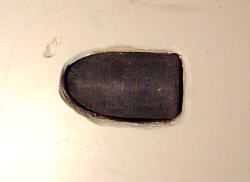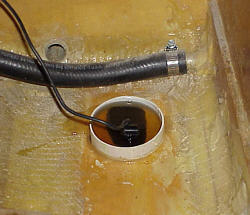|
The end result is that the sending unit is glued to the bottom and shooting through solid resin - not wood. This should allow it to work correctly and put and end to it kicking up. Another item I wanted to address was to weigh the CS. I am fairly sure it came out heavy but the question is how heavy? Thanks to fellow boatbuilder Tom Lathrop for offering a suggestion on how to weigh the CS quite easily while sitting on the trailer (see his excellent articles on building his "Liz" in Boatbuilder Nov/Dec 2000 and March/April 2001). The method involves using only one bathroom scale and a pocket calculator. (Click here for details) I ran the numbers and they put the question to rest. Glen-L's plans state that the hull weight should be about 500 lb.. I assume this means the hull and just the hull. No seats, wiring, bilge pump, instruments, steering cable, cleats, etc. - just the bare hull. That's a tough number for me to generate at this point. I have all this stuff and more installed so my weight will have to have it included. I did pull some items out. These are the things that although aren't part of the hull are ALWAYS onboard. Equipment like, life jackets, 1st aide kit, tool kit, spare prop, anchor, portapotty, berth cushions, fenders, mooring lines, VHF radio, depth sounder, hats, sunscreen, etc. Altogether it came up to about 75 lb.! Also remember the engine was off. There was about 60 lb of fuel and a 35 lb battery onboard I did not remove. So, if I subtract these the calculator puts the weight about 900 lb.. That's a lot more than 500 lb. but again this is with the seats, steering cable, engine controls, wiring, etc. So lets go the other way. What is the normal weight when under way. I add everything back in plus 200 lb for the outboard, 325 lb passenger weight, half tank fuel (95 lb.), and throw in another 15 lb for cooler, refreshments, beach chairs, etc. This puts the normal operating weight at 1650 lb.. I wanted to establish this figure just to see how it compared to the "Planing Boat Speed Chart" on Glen-L's web page. The numbers look like this - 1650 / 50 = 33 (weight divided by HP = factor). Moving up the chart at 33 shows the projected maximum speed to be 30 mph and that's very close to what I am getting. Interesting! Now just for the heck of it let's see what happens if I was lighter. Let's say that I am 250 lb. over weight (probably a fair guess). So that is 1400 / 50 = 28. Run that up the chart and it shows my top speed should have been 33 mph. That's a 3 miles per hour loss on top end because excess weight. Other modifications.
I also decided that I wanted to place a valve in the 3/4" fuel line that connects the two tanks. I have noticed that when using the CS by myself it tends to list slightly to the starboard when underway because of my weight. It seems that the fuel is then flowing to the low side which in turn makes the listing worse. By placing a valve in the line I can stop the flow. Also it will allow me to use the fuel weight to my advantage. By pulling fuel from only one tank I should be able to balance the load. If I have two on board I can just open the valve and equalize the amount of fuel in each side. This created another small problem. I have only one analog
fuel gauge and it is in the starboard tank. I want to be able to
monitor the other tank too so I decided to add another sending unit in
the port tank. Not wanting to add a second gauge I just wired in
a toggle switch on the instrument panel. It allows me to check each tank
by throwing the switch to the right or left.
|
 While
it is in the shop there are a couple of things I am going to change. The
first is moving the depth finder's sending unit from it's transom mounting
to a "through the hull" mounting. The rivers I run constantly seem to have
small debris floating and it doesn't take much for them to kick up the
sender. Then I either have to stop and reach down to the bottom of the
transom and re-set it (no fun when the water is 36 degrees) or continue
on without it working. For this reason I have always mounted them
on the inside of my fiberglass boats. But the sending units will
not function shooting through wood. This is why I mounted it on the outside.
Now though I am going to have to repaint the bottom where I have filled
it in so I might as well go ahead and make the modification. (First photo
is looking up at the hull bottom with the sending unit sitting in place.)
While
it is in the shop there are a couple of things I am going to change. The
first is moving the depth finder's sending unit from it's transom mounting
to a "through the hull" mounting. The rivers I run constantly seem to have
small debris floating and it doesn't take much for them to kick up the
sender. Then I either have to stop and reach down to the bottom of the
transom and re-set it (no fun when the water is 36 degrees) or continue
on without it working. For this reason I have always mounted them
on the inside of my fiberglass boats. But the sending units will
not function shooting through wood. This is why I mounted it on the outside.
Now though I am going to have to repaint the bottom where I have filled
it in so I might as well go ahead and make the modification. (First photo
is looking up at the hull bottom with the sending unit sitting in place.)
 What
I did was cut a hole in the hull near the transom knee. It was just
slightly larger than the sending unit and I will taper the edges making
them flare out somewhat. On the outside I took a piece of the countertop
material and wedge it in place to temporarily seal the hole. I then
cut a piece of 3" plastic pipe about 3/4" long to form aa ring. From
the inside I placed it around the hole and use hot glue tack it in place
and somewhat seal he bottom edge. This served as a mold. I
then poured epoxy into the hole until it is about 3/8" deep.
I allowed it to setup a little and then set the sending unit down into
the resin. Once positioned I filled the plastic pipe ring with epoxy.
What
I did was cut a hole in the hull near the transom knee. It was just
slightly larger than the sending unit and I will taper the edges making
them flare out somewhat. On the outside I took a piece of the countertop
material and wedge it in place to temporarily seal the hole. I then
cut a piece of 3" plastic pipe about 3/4" long to form aa ring. From
the inside I placed it around the hole and use hot glue tack it in place
and somewhat seal he bottom edge. This served as a mold. I
then poured epoxy into the hole until it is about 3/8" deep.
I allowed it to setup a little and then set the sending unit down into
the resin. Once positioned I filled the plastic pipe ring with epoxy.
 Originally
the engine set a little high on the transom. With the reshaping of
the bottom I decided to go ahead and lower the outboard to exactly 20".
I cut out the top of the transom, re-glassed the surface and set it down.
Originally
the engine set a little high on the transom. With the reshaping of
the bottom I decided to go ahead and lower the outboard to exactly 20".
I cut out the top of the transom, re-glassed the surface and set it down.